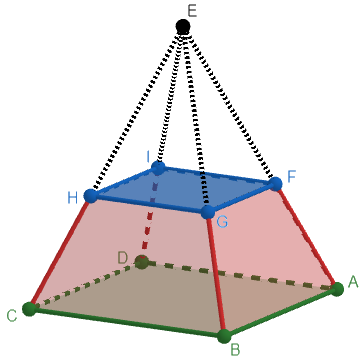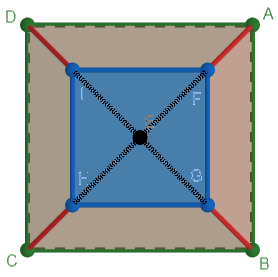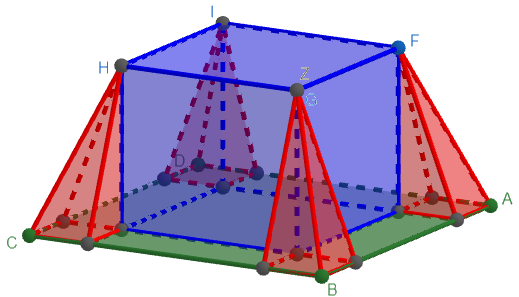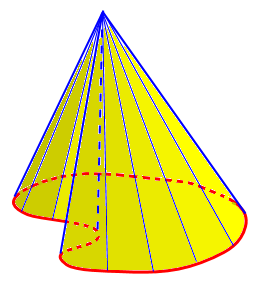We’ve looked in the past at volumes and surface areas of familiar geometric shapes like spheres, pyramids, and cones; but more can be done. If we cut parallel to the base of a pyramid or cone, the result is called a frustum (no, not a frustrum!). Let’s derive some formulas, which will be remarkably simple.
Frustum of a pyramid
We’ll start with the frustum of a pyramid, with this question from 2001:
Volume of the Frustum of a Pyramid I am trying to figure out how to derive the formula for the volume of a frustum of a pyramid. As it states in your formulas: V = (h(B1+B2+sqrt[B1B2])/3 I understand everything except where you get the sqrt[B1B2] - what does that part represent in the frustum?
A frustum is a solid that has been cut off from an object by a plane parallel to the base. Here is an example of a frustum of a square-based pyramid, the first example we’ll be looking at below:

We’ve cut the pyramid ABCDE with a horizontal plane, resulting in the square FGHI parallel to ABCD.
I answered:
Hi, Kerry. There are two main ways to derive this formula: dissection and subtraction. Let's try both.
Dissection means “cutting apart”; we’ll show that we can cut the frustum into pieces whose volumes add up to the desired formula. Subtraction means “taking away”; we’ll subtract the volume of the top part of the pyramid from the entire pyramid to find the volume of the remaining part, which is the frustum.
Proof by dissection, for a square base
I'll use the dissection method specifically for a square frustum, from which you can apply the formula to other cross-sections using Cavalieri's theorem. Here is a top view of a square frustum:
+---+----------+---+
| \ | d| / |
+---+----------+---+
| | | d |
| | | |
| | s1| |s2
| | | |
| | | |
+---+----------+---+
| / | d| \ |
+---+----------+---+
Here is the top view of my frustum above:

In my labeling, \(s_1\) is a side of the top (e.g. FG), \(s_2\) is a side of the bottom (e.g. AB), and \(\displaystyle d=\frac{s_2-s_1}{2}\) is the width of the extra space around the bottom. We’ll be calling the area of the top \(B_1\), and the area of the bottom \(B_2\).
Cavalieri’s theorem is discussed in Volume and Surface Area of a Sphere – Without Calculus. It says that if two figures have the same area in every cross-section (at any height from the base), then they have the same volume; so the formula we produce in terms of base areas will apply to any prism (and even to cones).
We are dissecting the frustum into these parts:

I have cut vertically through the sides of the top square, dividing the pyramid into nine parts:
a central square prism with volume s1^2*h
four corners that together form a pyramid of volume (2d)^2*h/3
four triangular prisms (on their sides), each with volume s1*d*h/2
The total volume is then
V = [s1^2 + 1/3 (s2-s1)^2 + s1(s2-s1)]h
= [s1^2 + 1/3 s2^2 - 2/3 s1*s2 + 1/3 s1^2 + s1*s2 - s1^2]h
= [1/3 s1^2 + 1/3 s2^2 + 1/3 s1*s2]h
= [s1^2 + s1*s2 + s2^2]h/3
Since B1 = s1^2 and B2 = s2^2, this is
V = [B1 + sqrt(B1*B2) + B2]h/3
So the formula for the volume of a square frustum whose bases have sides \(s_1\) and \(s_2\) is $$V=\frac{h}{3}(s_1^2+s_1s_2+s_2^2),$$ and the formula for the volume of any frustum whose bases have areas \(B_1\) and \(B_2\) is $$V=\frac{h}{3}(B_1+\sqrt{B_1B_2}+B_2),$$ which Kerry asked for.
Proof by subtracting the top
Now let's do it by finding the difference between the whole pyramid and the part cut off. This doesn't depend on the shape of the bases at all. Just look at the similar triangles formed in a side view:
+ -----------------------
/ \ ^
/ \ |
/ \ |k
/ \ |
/ \ v
+-----------------+ -----------
/ a \ ^
/ \ |h
/ \ v
+-----------------------------+ ---
b
It doesn't matter what a and b actually are; since horizontal cross-sections are all similar, any linear measurement is proportional to the square root of the area, so we know
b/a = sqrt(B2/B1)
Areas of similar figures are proportional to the square of any linear dimension (edge, height, radius), so $$\frac{B_2}{B_1}=\left(\frac{b}{a}\right)^2,$$ and $$\sqrt{\frac{B_2}{B_1}}=\frac{b}{a}.$$
We’ll be assuming that we know the height of the frustum, \(h\), and the two base areas, \(B_1\) on the top and \(B_2\) on the bottom. We don’t know the height of the entire pyramid.
First we have to find the height of the original pyramid, using similar triangles:
b/a = (h+k)/k = h/k + 1
so
h/k = sqrt(B2/B1) - 1
1
k/h = ---------------
sqrt(B2/B1) - 1
sqrt(B1)
= -------------------
sqrt(B2) - sqrt(B1)
sqrt(B1) (sqrt(B2) + sqrt(B1))
= ------------------------------
B2 - B1
The last step was multiplication by the conjugate: $$\frac{k}{h}=\frac{1}{\sqrt{\frac{B_2}{B_1}}-1}\\\\=\frac{1\cdot\sqrt{B_1}}{\left(\sqrt{\frac{B_2}{B_1}}-1\right)\cdot\sqrt{B_1}}\\\\=\frac{\sqrt{B_1}}{\sqrt{B_2}-\sqrt{B_1}}\\\\=\frac{\sqrt{B_1}\left(\sqrt{B_2}+\sqrt{B_1}\right)}{\left(\sqrt{B_2}-\sqrt{B_1}\right)\left(\sqrt{B_2}+\sqrt{B_1}\right)}\\\\=\frac{\sqrt{B_1}\left(\sqrt{B_2}+\sqrt{B_1}\right)}{B_2-B_1}$$
Now the volume of the frustum is the volume of the whole pyramid minus the volume of the top part:
V = B2(h+k)/3 - B1 k/3
= B2 h/3 + (B2-B1)k/3
= B2 h/3 + (B2-B1)h/3 * k/h
= B2 h/3 + sqrt(B1) (sqrt(B2) + sqrt(B1)) h/3
= [B2 + sqrt(B1B2) + B1]h/3
There, again, is the formula we wanted.
I included a reference to two derivations for the cone, which we’ll refer to below, and added:
The latter method is equivalent to that given in the Dr. Math archives for a frustum of a cone (since a pyramid is just a special cone).
Is a pyramid really just a special cone? A cone, in its most general form, is formed by joining every point of a curve in a plane (the directrix) to a point called the apex; that is explained in the Ask Dr. Math FAQ:

If the directrix is a polygon, we call this a pyramid; if it is a circle, we call it a circular cone, which is the usual meaning of the word.
Subtraction, a little differently
A 2002 question elicited a variation of the second derivation:
Volume of a Frustum of a Pyramid Hi Dr. Math. I don't know how to prove that the formula V = h/3 * (B1 + sqrt(B1*B2) + B2) is correct for a frustum of a pyramid.
I answered:
Hi, Zizza.
Here is one way to derive the formula:
If we reconstruct the entire pyramid, the top part, with base area B2, is similar to the whole pyramid, with base area B1. Their heights must therefore be in the ratio sqrt(B1):sqrt(B2). The height of the whole pyramid is therefore sqrt(B1)/(sqrt(B1)-sqrt(B2)) h, and its volume is
Vwhole = 1/3 B1 * sqrt(B1)/(sqrt(B1) - sqrt(B2)) h
while the volume of the removed top part is
Vremoved = 1/3 B2 * sqrt(B2)/(sqrt(B1) - sqrt(B2)) h
(Here I used \(B_1\) for the bottom base, and \(B_2\) for the top, reversing the notation from before.)
The two heights are the distances from the apex of the complete pyramid to the two bases of the frustum, called \(h+k\) and \(k\) above; so $$\frac{h}{k}+1=\frac{\sqrt{B_1}}{\sqrt{B_2}}\\\frac{h}{k}=\frac{\sqrt{B_1}}{\sqrt{B_2}}-1=\frac{\sqrt{B_1}-\sqrt{B_2}}{\sqrt{B_2}}\\\frac{k}{h}=\frac{\sqrt{B_2}}{\sqrt{B_1}-\sqrt{B_2}}\\k=\left(\frac{\sqrt{B_2}}{\sqrt{B_1}-\sqrt{B_2}}\right)h,$$
and the total height is $$h+k=h+\left(\frac{\sqrt{B_2}}{\sqrt{B_1}-\sqrt{B_2}}\right)h=\\\left(1+\frac{\sqrt{B_2}}{\sqrt{B_1}-\sqrt{B_2}}\right)h=\left(\frac{\sqrt{B_1}}{\sqrt{B_1}-\sqrt{B_2}}\right)h.$$ These are multiplied by \(\frac{1}{3}\) times each base to get the volumes, $$V_{whole}=\frac{B_1}{3}\left(\frac{\sqrt{B_1}}{\sqrt{B_1}-\sqrt{B_2}}\right)h\\V_{removed}=\frac{B_2}{3}\left(\frac{\sqrt{B_1}}{\sqrt{B_1}-\sqrt{B_2}}\right)h.$$
Subtracting, we get
Vfrustum = Vwhole - Vremoved
= h/3 * [B1*sqrt(B1) - B2*sqrt(B2)]/[sqrt(B1) - sqrt(B2)]
= h/3 * [sqrt(B1)^3 - sqrt(B2)^3]/[sqrt(B1) - sqrt(B2)]
So the frustum is $$V_{frustum}=\frac{h}{3}\left(\frac{\sqrt{B_1}^3-\sqrt{B_2}^3}{\sqrt{B_1}-\sqrt{B_2}}\right).$$
But the difference of cubes can be factored:
a^3 - b^3 = (a - b)(a^2 + ab + b^2)
so we get
Vfrustum = h/3 * (B1 + sqrt(B1*B2) + B2)
which is just what we wanted.
$$V_{frustum}=\frac{h}{3}\left(B_1+\sqrt{B_1B_2}+B_2\right).$$
Had you noticed the similarity \(B_1+\sqrt{B_1B_2}+B_2\) to \(a^2+ab+b^2\)? This makes the formula quite memorable.
Now we’ll do some similar thinking for the cone.
Frustum of a cone
Here is a 1999 question about both surface area and volume:
Volume and Surface Area of a Cone Frustum I have looked at your examples of the different types of cones, but I am unable to figure out how you derived the formula for the volume and total surface area for the frustum of a right circular cone.
Notice that our volume formula above applies to any pyramid, regardless of the shape of the base, or even whether the apex is above the center of the base (whatever that even means for a polygon). We could only find the surface area for such a wide variety of shapes by adding up the areas of the faces.
We’ll see that the same volume formula applies to a cone. But now we’ll be focusing on the right circular cone, with a circular base and with the apex above the center of the circle; this is specific enough that we’ll be able to find the surface area, too.
I answered, starting with the same two links I omitted above:
Hi, Chris. You haven't said where you saw a derivation of these formulas; I found these pages for the volume, and none for the area: Deriving the Volume of a Frustum http://mathforum.org/dr.math/problems/taylor5.6.98.html Derivation of the Formula for the Frustum http://mathforum.org/dr.math/problems/rizza08.09.99.html I'm going to assume that you are happy with the formulas for a cone, and only want to see how we can get from there to the formulas for a frustum. If you want more than I give you, feel free to write back.
I’ll be expanding and clarifying those brief explanations here.
Volume
First let's do the volume. Rather than repeat what the other pages explain, I'll try a slightly different approach, still using similar triangles. Here's my picture:
--------------------- +P --------------------
| /|\ |
| / | \ |
| / | \ S-s |H-h
| / | \ |
| / | \ |
| /*****|**r**\ |
| ** C+-----*+D--------------
H| S / *********** \ |
| / | \ |
| / | \ |
| / | \ s |
| / | \ |h
| / | \ |
| / | \ |
| / **********|********** \ |
| /***** | R *****\ |
-----* A+----------------+B----
****** ******
*********************
We know R, r, and h, but not H, the total height of the cone from which the frustum was cut. If we can find it, then the volume of the frustum will be the volume of the whole cone, pi R^2 H/3, minus the volume of the cone we cut off the top, pi r^2 (H-h)/3.
We’ll find \(H\), which corresponds to \(h+k\) in the work above, in much the same way we did before.
The triangles PAB and PCD are similar, so we can write the equation
AB CD R r
-- = -- or - = ---
PA PC H H-h
Cross-multiplying [that is, multiplying both sides by H(H-h)], we get
R(H-h) = rH
We can distribute the left side and collect H terms, then divide:
RH - Rh = rH
RH - rH = Rh
(R-r)H = Rh
Rh
H = ---
R-r
Now we can subtract the top of the cone (with radius \(r\) and height \(H-h\)) from the whole (with radius \(R\) and height \(H\).
Now let's write the volume formula and substitute this formula for H:
pi pi
V = -- R^2 H - -- r^2 (H-h)
3 3
pi
= -- (R^2 H - r^2 H + r^2 h)
3
pi
= -- [(R^2 - r^2) H + r^2 h]
3
pi Rh
= -- [(R^2 - r^2) --- + r^2 h]
3 R-r
pi R
= -- [(R^2 - r^2) --- + r^2] h
3 R-r
We can write R^2 - r^2 as (R - r)(R + r) and cancel:
pi
= --- [(R + r) R + r^2] h
3
pi
= --- [R^2 + Rr + r^2] h
3
That's the formula.
Here we factored a difference of squares, rather than a different of cubes as before!
The result is the same as the general formula we got above for a pyramid: $$V_{frustum}=\frac{h}{3}\left(B_1+\sqrt{B_1B_2}+B_2\right)=\frac{h}{3}\left(\pi R^2+\sqrt{\pi R^2\pi r^2}+\pi r^2\right)=\frac{\pi h}{3}\left(R^2+Rr+r^2\right)$$
Surface area
Now let's work on the lateral surface area. The formula for a complete cone is:
A = pi R S
where R is the radius and S is the slant height of the whole cone. For the frustum, we will subtract the area of the cut-off cone (whose slant height is S-s) from the whole:
A = pi R S - pi r (S-s)
= pi (RS - rS + rs)
= pi ((R-r)S + rs)
We’ll see why I did that last step of factoring.
By the same similar triangles as before, we can write
AB CD R r
-- = -- or - = ---
PB PD S S-s
Again solving for S,
R(S-s) = rS
RS - Rs = rS
RS - rS = Rs
(R-r)S = Rs
Rs
S = ---
R-r
This is essentially the same as our formula for H.
Now the area is
Rs
A = pi ((R-r)--- + rs) = pi (Rs + rs) = pi(R+r)s
R-r
and we're done.
This is very much like the formula for area of a trapezoid, \(A=\frac{B+b}{2}h\), which is the area of a rectangle whose width is the average of the two “widths”, B and b. In fact, we can write the formula as $$A=2\pi s\frac{R+r}{2},$$ the area of a cone whose radius is the average of the two radii of the frustum.
Next week: Shapes that seem like frustums, but aren’t. And after that: What if you cut a cone at an angle, rather than straight across?

Pingback: Looks Like a Frustum, But … – The Math Doctors